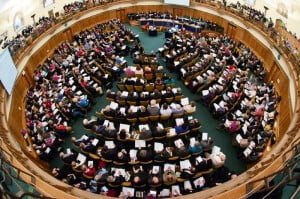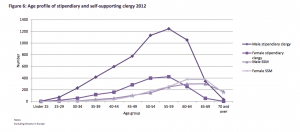Gender, representation and Synod
 There have been some interesting responses to my previous mail on Synod, representation and gender—thanks to all who provided corrections to the data for individual diocese, and filled the gaps. Two kinds of responses predominated in the conversation on Facebook, which became quite lively. They are encapsulated by the response of my colleague Amanda Digman on the blog:
There have been some interesting responses to my previous mail on Synod, representation and gender—thanks to all who provided corrections to the data for individual diocese, and filled the gaps. Two kinds of responses predominated in the conversation on Facebook, which became quite lively. They are encapsulated by the response of my colleague Amanda Digman on the blog:
The two major reasons I didn't put my name forrad were ane) I have children at dwelling. I'm already away for diocesan briefing and my annual retreat and usually something else comes up and I'm often out in the evenings or worse tea fourth dimension (school governors meetings). I just think I want to wait until they have flown the nest (or since that may take a lot longer than in the by, don't want me effectually all the time)! Also, if I remember correctly, one session is in a one-half term and our family holidays are precious. in that location may not be many more. The other reason (2) is that I don't feel confident plenty to stand up up at a hustings and tell everyone why I'm the all-time candidate (because peradventure I'g not!).
On the starting time question, childcare, there were a good number of supporting observations from people who felt the same. There was an of import reminder not to stereotype—not all ordained women are married or have children—but making observations about a accomplice of people is not the aforementioned thing as stereotyping. There was also some protest confronting theexpectation that women should be the ones primarily responsible for childcare. But in fact the comments were not expressing expectation—they were documenting reality as information technology is expert. Whether we think it is a practiced thought or not, the reality is that, where both partners in a marriage are in full-time employment or ministry, fathers find it easier to be away from childcare than mothers.
On the 2d question, confidence, there were also some strong comments. One person observed:
I remember this gets at a core issue of women in positions of leadership across a lot of culture – women wait to be asked or are afraid they'll be judged if they stand for leadership roles or need affirmation. I know that'due south a generalisation just I see it A LOT in the young women I teach and mentor. The inner vocalization 'am I good enough' is something I've seen a lot of.
and another responded:
I think that's exactly it, in fact I recall I read some research somewhere about men and women applying for senior roles. when it comes to the 'essential' criteria on the task spec a man is more likely to apply even if he matches simply a modest number of the criteria but a woman on average, will simply employ if she matches almost all.
There followed some powerful personal testimony about how the issue of confidence has affected this person as a woman. (I haven't included names, since I have non asked permission to identify the individuals.) It is non surprising that the Church building and Synod face up the same kinds of bug that we see in wider society in relation to gender differences in representation.
But that is but half the story. Having asking the question, 'Why are three times as many men every bit women clergy standing for Synod?' I was taken back past one response on Twitter:
@Psephizo because there are three times as many men as women clergy? https://t.co/kcZfb3Pbsa
— sue penfold (@PenfoldSue) September 24, 2015
The reference is to the latest set of Statistics for Ministry which are from 2012. As Sue points out, it gives the numbers for clergy in unlike roles carve up past sex activity. Hither are the headlines:
- Female clergy now account for 23% of full-time parochial clergy and 11% of senior clergy
- Stipendiary male clergy: half dozen,017 (77%)
- Stipendiary female clergy: one,781 (23%)
- Self supporting male clergy: i,488 (47%)
- Self-supporting female clergy: i,660 (63%)
- Total male person clergy: 7,505 (69%)
- Total female person clergy: 3,441 (31%)
In other words, at that place are two and a half times equally many male clergy overall equally female—and 4 times as many stipendiary men every bit women. And then having 3 times every bit many men standing every bit women might be an accurate, fair and proportionate reflection of overall clergy numbers.
What can we learn from this, and from the discussion about the numbers?
- It is interesting to me that only one person, in all the correspondence, pointed out that the numbers I had quoted needed to be put in a wider context. The thought had occurred to me at the time, and I had originally intended to make a annotate to that effect, only I was and then struck past the disparity that information technology slipped my mind. There is also another context to put this in, which is the relative representation in previous years.
- The reason why I had been so struck by the figures was the situation of my own diocese. We are well-nigh 50% women in ordained ministry building, and I realised that I therefore spend a lot of my time relating to women clergy and in meetings where at that place is a adequately equal mix. Information technology was therefore extremely odd to be in a room of candidates who were all male. Of class, it is not the case in every role of the church building—as the numbers clearly demonstrate. But it was striking how much my response was shaped by my own context and feel. Whenever we reverberate on these issues we need to be prepared to 'practice the math' and check our ain experience against it.
- Having said that, there are clearly some deeply felt issues, and I am glad that raising this question provided some space to air these views. Nosotros need to continue to have them seriously—and maybe this ought to feed into the calendar of Synod itself.
- Aslope that, in that location are contrasting voices which we demand to heed out for, and which are almost never heard—the voice of men who feel displaced by the call to stand for women fairly. The bottom line is that, if Synod ends up being more female than the listing of candidates is, and so male clergy will be (proportionately) under-represented. How do we balance this against the need to encourage women to let their voices exist heard in a Church which is undergoing transition?
- As a number of commentators pointed out, there is another whole question of representation that is waiting to be addressed—the presence of black and minority ethnic people on Synod and in wider Church building leadership.
 The Statistics for Ministry building are well worth perusing for other issues as well. A couple that caught my eye related to the distribution of clergy and the age of preparation.
The Statistics for Ministry building are well worth perusing for other issues as well. A couple that caught my eye related to the distribution of clergy and the age of preparation.
Table 4 shows the population per stipendiary clergy. It turns out that at that place are 10 dioceses (more often than not rural) where there are roughly twice equally many clergy per head of population compared with 7 other dioceses (which are generally urban). Given that church attendance is higher in rural areas, and that well-nigh of our population is centred in the cities—and that, historically, Christianity grew as an urban motion—this raises some serious questions about strategy for overall clergy deployment.
Table half-dozen (shown here) show the age profile of clergy, and the large bulge in the 55–59 age subclass is the cause of virtually all our challenges in mission and ministry building. And we are all the same not grooming people at the right age to correct this imbalance (Figure xx). So much more needs to be washed in encouraging young vocations.
Follow me on Twitter @psephizo
Much of my work is washed on a freelance ground. If you have valued this post, would you considerdonating £1.20 a month to support the production of this blog?
If you enjoyed this, practise share it on social media (Facebook or Twitter) using the buttons on the left. Follow me on Twitter @psephizo. Like my page on Facebook.
Much of my work is washed on a freelance footing. If you have valued this post, you can make a single or repeat donation through PayPal:
For other ways to support this ministry, visit my Support page.
Comments policy: Good comments that engage with the content of the mail service, and share in respectful debate, can add real value. Seek get-go to understand, then to be understood. Make the nearly charitable construal of the views of others and seek to learn from their perspectives. Don't view debate as a conflict to win; address the argument rather than tackling the person.
Source: https://www.psephizo.com/life-ministry/gender-representation-and-synod/
0 Response to "Gender, representation and Synod"
Yorum Gönder